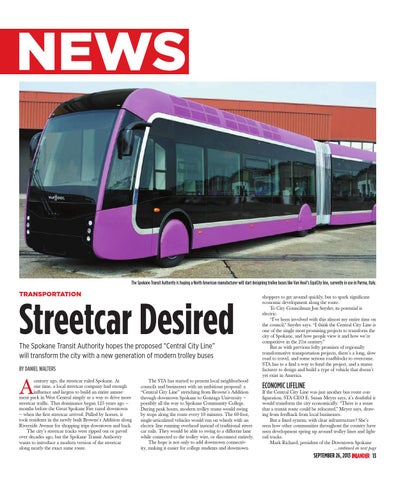The Spokane Transit Authority is hoping a North American manufacturer will start designing trolley buses like Van Hool’s EquiCity line, currently in use in Parma, Italy.
TRANSPORTATION
Streetcar Desired The Spokane Transit Authority hopes the proposed “Central City Line” will transform the city with a new generation of modern trolley buses BY DANIEL WALTERS
A
century ago, the streetcar ruled Spokane. At one time, a local streetcar company had enough influence and largess to build an entire amusement park in West Central simply as a way to drive more streetcar traffic. That dominance began 125 years ago — months before the Great Spokane Fire razed downtown — when the first streetcar arrived. Pulled by horses, it took residents in the newly built Browne’s Addition along Riverside Avenue for shopping trips downtown and back. The city’s streetcar tracks were ripped out or paved over decades ago, but the Spokane Transit Authority wants to introduce a modern version of the streetcar along nearly the exact same route.
The STA has started to present local neighborhood councils and businesses with an ambitious proposal: a “Central City Line” stretching from Browne’s Addition through downtown Spokane to Gonzaga University — possibly all the way to Spokane Community College. During peak hours, modern trolley trams would swing by stops along the route every 10 minutes. The 60-foot, single-articulated vehicles would run on wheels with an electric line running overhead instead of traditional streetcar rails. They would be able to swing to a different lane while connected to the trolley wire, or disconnect entirely. The hope is not only to add downtown connectivity, making it easier for college students and downtown
shoppers to get around quickly, but to spark significant economic development along the route. To City Councilman Jon Snyder, its potential is electric. “I’ve been involved with this almost my entire time on the council,” Snyder says. “I think the Central City Line is one of the single most promising projects to transform the city of Spokane, and how people view it and how we’re competitive in the 21st century.” But as with previous lofty promises of regionally transformative transportation projects, there’s a long, slow road to travel, and some serious roadblocks to overcome. STA has to a find a way to fund the project, and a manufacturer to design and build a type of vehicle that doesn’t yet exist in America.
ECONOMIC LIFELINE
If the Central City Line was just another bus route configuration, STA CEO E. Susan Meyer says, it’s doubtful it would transform the city economically. “There is a sense that a transit route could be relocated,” Meyer says, drawing from feedback from local businesses. But a fixed system, with clear infrastructure? She’s seen how other communities throughout the country have seen development spring up around trolley lines and lightrail tracks. Mark Richard, president of the Downtown Spokane ...continued on next page
SEPTEMBER 26, 2013 INLANDER 13
